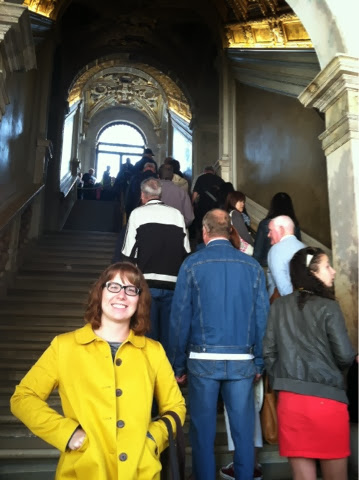We are going to be on a bus most of the day today, so I actually have time to post a little something about our day yesterday.
We woke up very early and headed to Florence by bus. On the way, it was very hilly and we drove through the Apennine mountains. The landscape was dotted with villages, most dating back to the Medieval Era. People still live in these villages, taking very good care of their very old homes.
The ride through the city of Florence was awful. Many of us, including myself, suffered from motion sickness. Traffic rules are very different there. Our guide told us that, despite the fact that there are lanes, people generally drive wherever they can find space. There's a major university in Florence, and students get around using scooters. They squeeze through spaces between cars at insane speeds. Needless to say, I was very happy to get off the bus when we finally arrived.
We passed a public library, or biblioteca, on our way to the center of the city. It was a beautiful building right next to the water. Our guide didn't want to stop, but she mentioned that the river once flooded and reached the library, destroying many original texts and artifacts.
Do you like my bright blue necklace? It's an earpiece called a "Whisper ". Our guide made us wear them so she could talk to us while we walked around. I thought they were dorky and screamed, "I'm an American tourist! Please pick my pocket!", so I rarely wore it. She tried lecturing me about it once, but I politely told her that I was fine without it.
I liked Florence right away because it was less crowded than Venice. It was also very quiet. After we passed the University, there were mostly pedestrian streets, so there wasn't any traffic noise like we hear in Indianapolis. The atmosphere is very calm, and we were lucky enough to be there on a nice day.
Lunch in the center of Florence.
Streets of Florence. Look, no cars!
Tourists put locks on a monument in the jewelry district to symbolize eternal love.
Police making sure we don't do anything illegal, I guess.
Our first stop was the church that houses Dante and Machiavelli's funerary monuments, Basilica of Santa Croce. Both men are incredibly important figures in literary history. I studied Dante's Divine Comedy in college. His writing vividly details a journey through the different levels of Hell after death. The modern Italian language originates from this text, and people say that the "most correct" Italian dialect is spoken in Florence because it is where Dante lived. Unfortunately, we didn't get to go inside. Churches close at 5:00, and our free time didn't start until 5:30. I did, however, get a picture of the outside.
The main event in this city was the Duomo, the Basilica of Saint Mary of the Flower. This basilica is famous for it's dome, the largest in Italy. I learned that it took over 100 years to build the cathedral, but the dome didn't exist for 25 years after the cathedral was finished. Apparently, there was just a gaping hole open to the elements until a brave engineer named Brunelleschi proposed a plan during a competition between architects. I could go on forever about how it was built, but I wouldn't do it justice. It's just beautiful. First of all, it's enormous. You can see it from anywhere in Florence. On this inside, it's painted with incredibly realistic frescos that look as if their popping out of the walls. This perspective is unique to the renaissance.
After touring the Duomo, we watched a leather demonstration. Florence is known for their leather goods and gold jewelry. It was neat, but I was more interested in the monuments and sculptures. It was hard for me to believe that I was walking around in the birthplace of the renaissance, a cultural movement beginning around the 1300s. Florence is where you'll see Michelangelo's sculpture of David and see where Dante and Leonardo Da Vinci lived and went to church.
A private palace built where Da Vinci once lived.
We spent a day in Florence, but we only scratched the surface. I wish we could have stayed longer because I spent most of college learning about great pieces of literature that were written there. I guess that just means I'll have to go back someday.
























































